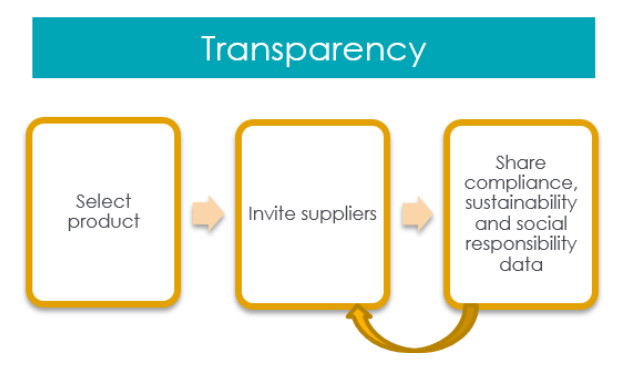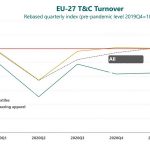Implementing the tools necessary to achieve transparency can be done with relatively low impact on existing processes and systems. Once the right solution is found, it can be used for all product types and easily scaled up to meet the needs of global supply chains.
With 2020 now behind us, many of us are looking forward to the new year. While we do not know what 2021 has in store, there is something we know for certain: 2021 will be a year of action for businesses who want to ensure more responsible sourcing.
Transparency: Mapping the Supply Chain
Transparency captures high-level information regarding a supply chain: a product’s components, names of suppliers, locations of facilities, associated certifications, etc. But “high-level” does not mean vague. Through transparency, businesses can identify the all suppliers for all the components in a product, down to the source, as well as capture specific information related to these suppliers—such as a facility’s certifications, certifying body, expiration date, and even a copy of the certification itself. Transparency also enables companies to identify, map, and connect with their supply chain network to collect previously unknown product information and/or communicate and establish specific requirements. In this way, companies can gain better visibility of their global supply chains and ensure compliance with safety, sustainability, and social responsibility requirements.
It goes without saying that efforts to respond to and recover from the pandemic are still top of mind as we begin the year. But responsible sourcing is a long-term commitment that requires steady and consistent progress, and businesses cannot afford to put their responsible sourcing programs on hold. Sustainable and ethical supply chains are becoming non-negotiable for consumers and investors alike, and 2021 provides the opportunity for valuable progress to be made.
We recommend three responsible sourcing guidelines to help you make real and tangible progress towards your goals.
Prioritize responsible sourcing
To ensure continued progress, responsible sourcing must remain a top priority for your business, even as you work to respond to the pandemic. While it may be tempting to focus solely on the most pressing issues, neglecting responsible sourcing programs, even temporarily, can cause you to fall behind on your commitments, lose customer loyalty, and lose valuable momentum established by previous or existing efforts. In 2020, many businesses continued to make progress towards their sustainability goals, despite obvious disruption.
The pandemic has forced many issues around crisis management and supply chain disruption to the forefront. But addressing these challenges should not come at the expense of responsible sourcing. In fact, the same foundational knowledge—a better understanding of your suppliers and the risks impacting your supply chains—helps you achieve both greater supply chain resilience and more ethical and sustainable sourcing. By prioritizing efforts to increase supply chain visibility, engage with suppliers, and identify and mitigate risks, you are supporting both your pandemic response plan and your responsible sourcing commitments.
Reimagine supplier relationships
Traditionally, supplier-buyer relationships have been largely transactional, meaning they are based solely on the transaction between the two parties: what is the supplier providing the buyer, at what cost, and for what length of time. But the increased focus on corporate sustainability, and the unanticipated challenges posed by the Covid-19 pandemic, have led businesses to rethink how they interact with suppliers.
Greater supplier collaboration is needed to address and meet ambitious sustainability and responsible sourcing goals. For example, to achieve their goal of reducing greenhouse gas 30% by 2030, Adidas has adopted a “coaching” role for its strategic tier and 2 suppliers. Adidas’ senior director of social-environmental affairs Tracy Nilsson emphasizes that “open and transparent dialogue to set mutual expectations with suppliers is a must.”
Supplier collaboration and successful responsible sourcing programs go hand in hand. If your supplier interactions are largely transactional, consider taking steps to build strategic partnerships and connect more meaningfully with your supply chain.
Be scalable from the start
It is true that a responsible sourcing program begins with a single project and a single supply chain. But the eventual goal for most businesses is to achieve sustainable and ethical operations across the entire product range, across all supplier tiers. Consumers want to see that businesses are making continual, long-term efforts to achieve lasting change.
This means that any practices, processes, and tools implemented to support your responsible sourcing efforts should ultimately be scalable across your entire business. Investing in a foundational set of tools capable of supporting your business at every step—from initial pilot projects to later expansion across multiple product lines—is essential to build an effective responsible sourcing program. While this level of commitment often requires greater upfront investments in terms of time, money, and resources, a focus on scalability from the starts lays the essential groundwork to achieve responsible sourcing across your entire business.
Looking ahead
2021 can be more than just a year for recovery; it is a year that offers many opportunities for progress and growth. Even amid the pandemic, consumer demand for sustainable and responsible sourcing continues to increase. Transparency-One helps businesses meet this growing demand by making it easy to implement these responsible sourcing guidelines into their operations. With Transparency-One, companies can connect with their supply chains, mitigate risk, and ensure compliant and ethical practices to meet CSR commitments and assure long-term success.
By following these responsible sourcing guidelines—keeping sustainability top of mind, collaborating with suppliers, and prioritizing scalability—you can ensure that your business’ responsible sourcing program will continue to make strides in 2021 and beyond.
About Transparency-One
Transparency-One enables companies to discover, analyze, and monitor all suppliers, components, and facilities in the entire supply chain. Transparency-One combines cutting-edge graph database technology, supply chain expertise, and global supplier onboarding services, in partnership with SGS, to help all supply chain stakeholders reduce business risk. The company is based in Boston, Massachusetts with offices in Paris, France.
(By KellyAnn Tsai Director of Marketing at Transparency-One, Houston, Texas, United States)








